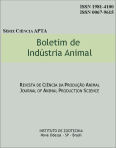Effects of mineral nitrogen and legumes na colonialgrass, Ponicum maxinium Jacq., dry matter production
Abstract
Colonialgras (Panicum maximum Jacq.) mixed with five tropical legumes on fertilized with increasing levels of N was studied in a field plot experiment carried out at the Estação Experimental de Nova Odessa of the Instituto de Zootecnia, in the State of São Paulo. The soil of the place is a Red-Yellow Podzolic one, variation laras. The legumes studied were: centrosema (Ceritrosema pubescens Benth.), perennial soybean (Glycine wightii), siratro (Macroptilium atropurpureum (DC.) Urb.), galáxia (Galaxia striata (Jacq.) Urb ), and stylo (Stylosanthes guyanensis (Aubl.) Sw). Results of three years shoved that colonial grass (Galactia striata) mixture yielded the equivalent to colonial grass alone fertilized with 181 kg of N/ha/year. Colonialgrass mixed with either one of the other four legumes yielded the equivalent of the grass alone fertilized with 40 to 93kg of N/ha/ year. Colonialgrass mixed with either one of the five legumes showed greater protein, P and Ca contents than colonialgrass fertilized with the hightest level of N used (225 kg of N/ha/year).Downloads
Downloads
Published
Issue
Section
License
Os autores não serão remunerados pela publicação de trabalhos, pois devem abrir mão de seus direitos autorais em favor deste periódico. Por outro lado, os autores ficam autorizados a publicar seus artigos, simultaneamente, em repositórios da instituição de sua origem, desde que citada a fonte da publicação original seja Boletim de Indústria Animal. A revista se reserva o direito de efetuar, nos originais, alterações de ordem normativa, ortográfica e gramatical, com vistas a manter o padrão culto da língua e a credibilidade do veículo. Respeitará, no entanto, o estilo de escrever dos autores. Alterações, correções ou sugestões de ordem conceitual serão encaminhadas aos autores, quando necessário. Nesses casos, os artigos, depois de adequados, deverão ser submetidos a nova apreciação. As opiniões emitidas pelos autores dos artigos são de sua exclusiva responsabilidade. Todo o conteúdo deste periódico, exceto onde está identificado, está licenciado sob a Licença Creative Commons Attribution (CC-BY-NC). A condição BY implica que os licenciados podem copiar, distribuir, exibir e executar a obra e fazer trabalhos derivados com base em que só se dão o autor ou licenciante os créditos na forma especificada por estes. A cláusula NC significa que os licenciados podem copiar, distribuir, exibir e executar a obra e fazer trabalhos derivados com base apenas para fins não comerciais.













